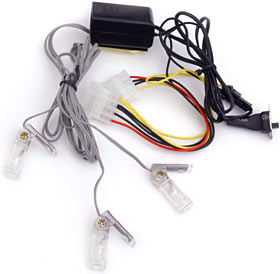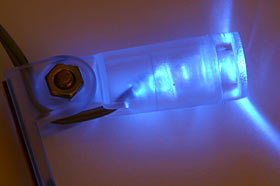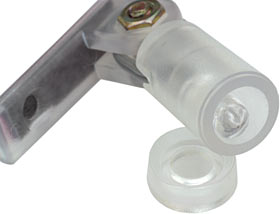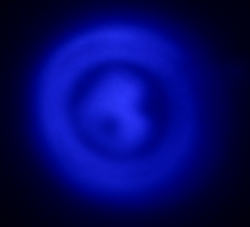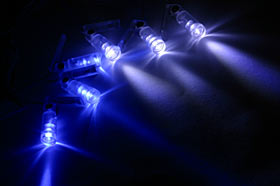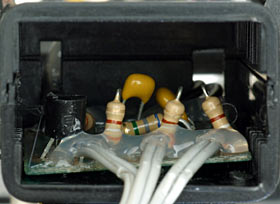
FlexiGlow Lazer Beam LED kits
Review date: 7 July 2003.Last modified 03-Dec-2011.
These are little tiny spotlights for use inside our outside your PC.
They're quite cheap - $AU19.95 plus delivery here in Australia, for three lights. They have always-on or slow flash modes, selectable with a little slide switch; in the flash mode, they're on for a bit more than a second, then off for a bit more than a second. They're easy to install and aim. They come in red, green, white, blue and near-ultraviolet, though I've only played with the blue and white models. They're simple, they work, and you'll probably know already if you want them.
If that's all you need to know about FlexiGlow's Lazer Beam LED kits, and you'd like to buy one, and you live in Australia, please refer to the box to the right for instructions on how to do so. Thank you.
If you'd prefer a bit more review, read on.
The Lazer Beam LEDs kit is simple enough. One passthrough four-pin power connector (so you don't need a spare PSU plug), one three-position switch (always-on, off, flash), one control box, three figure-8 wire strands to the lamps.
The lamp wires are a generous 70-odd centimetres long (getting on for 28 inches), so they shouldn't hold you back much in positioning the LEDs. If you need more wire, then anyone halfway handy with a soldering iron will be able to graft in some light duty speaker cable to extend the lamps another metre or three, without significantly reducing their brightness.
The Lazer LED lamp assemblies each contain one ordinary 5mm high intensity LED. The surrounding plastic isn't really needed to protect the LED (unlike filament lamps, LEDs are tough as nails), but they do allow them to be easily aimed. Each lamp can hinge through 180° relative to its base, and there's a little strip of self-adhesive material on the bases so you can stick the lamps wherever you want.
The end of each lamp also has a press-in lens that narrows the LED's beam width.
The lenses are easy to remove; without them, the beams are wider and the coloured LED beam is more even.
The white LED beam looks pretty much like this, whether or not the lens is there. It's just narrower with the lens. At 30cm (1 foot), the beam from the white LEDs is about 11cm (4.5 inches) across. Remove the lens, and it's more like 25cm (10 inches). If you want to stick the LEDs to your monitor and use them to light up your keyboard, you'll like this.
The white Lazers have a pretty typical cheap high intensity white LED beam. It's very blue-white, and bluer in the middle, where the most light from the blue LED die sitting under its phosphor coating leaks through. The phosphor blob contributes frequencies other than blue, to give the aggregate white light; it's what gives white LED their smooth output. The blob is rather larger than the die lurking under it.
The blue LED beams, in contrast, look like this with the lens attached. You're seeing a blurry picture of the LED die, in the middle. The other coloured Lazer LEDs probably have similar beams.
The smaller light source in the coloured LED gives a narrower beam; the blue LED beams are only about 8cm (3 inches) across at 30cm. Without the extra lenses, they're more like 13cm (5 inches) across, and less uneven as well. The extra lens focuses the image of the die.
At the distances at which people use LED flashlights, the unevenness of the light from coloured LEDs is seldom noticeable. The Lazer LEDs are likely to be used to illuminate things a foot or less from them, though, so the unevenness is worth noting.
That said, though, these things are perfectly good little spotlights, particularly considering how little they cost.
The blue LEDs are a bit disappointingly dim compared with the white ones, but they'll still do fine for accent lighting of something a foot away in a normally lit night-time room, or much further in dim light or darkness.
I pressed one of the white Lazer lamps against the diffuser of my light meter (not a good way to get exact brightness information, but worth a try for a vague ballpark estimate) and got a reading of about 5700 lux. My little Arc-AAA with a fresh battery, though, scored about 21000 lux in the same situation. It's got a high quality white LED and is driving it pretty hard; the Lazer lamp hasn't, and isn't. But it'll do.
Fiddling
The Lazer LED controller boxes are glued together, but the terminally inquisitive can pop an end panel off and peer inside.
Pretty much what I expected. Current limiting resistors for each of the three LEDs (they're running in three parallel circuits, each with its own series resistor), and a few other components, including one lonely transistor, for the flasher mode.
Doing the bench-supply-and-two-multimeters routine revealed that the blue Lazer LED kit in always-on mode draws about 63mA at 12 volts, and the white one draws about 72mA.
Given the simple LED wiring, this means each the lamps in these things are running between the conservative 20mA and the still-fairly-conservative 30mA that you normally see on high intensity LED spec sheets, which means they ought to last for a very long time indeed. The usually quoted LED lifespan is 100,000 hours of on-time before falling to 80% of the original brightness, with quite a lot more life beyond that.
Nobody's ever actually tested a modern high intensity LED for that long - they haven't existed for the 11.4 years that'd be needed - but it's still reasonable to expect these things to last forever, by computer standards.
Overall
The Lazer Beam LED kits are another 12 volt PC-lighting gadget that's clearly closely related to similar 12 volt car-lighting gadgets. The Hong Kong FlexiGlow site even lists a cigarette lighter plug adapter for the Lazer LEDs, so you can get the best of both worlds, as it were.
Thanks to their stick-on hinge lamp assemblies, though, these things could be used for something other than lighting up technological objects and/or the disco ball hanging from your rear vision mirror. You could, for instance, install them in a display case to light up small models or ornaments, or easily adapt them into searchlights or headlights for inclusion in models.
So the Lazer LEDs may be of interest to people outside the case modding community.
As I said in the executive summary at the top of the review, though; they're simple, they work, and you'll probably know already if you want them.
Lazer Beam LED kits kindly provided by FlexiGlow Australia.
